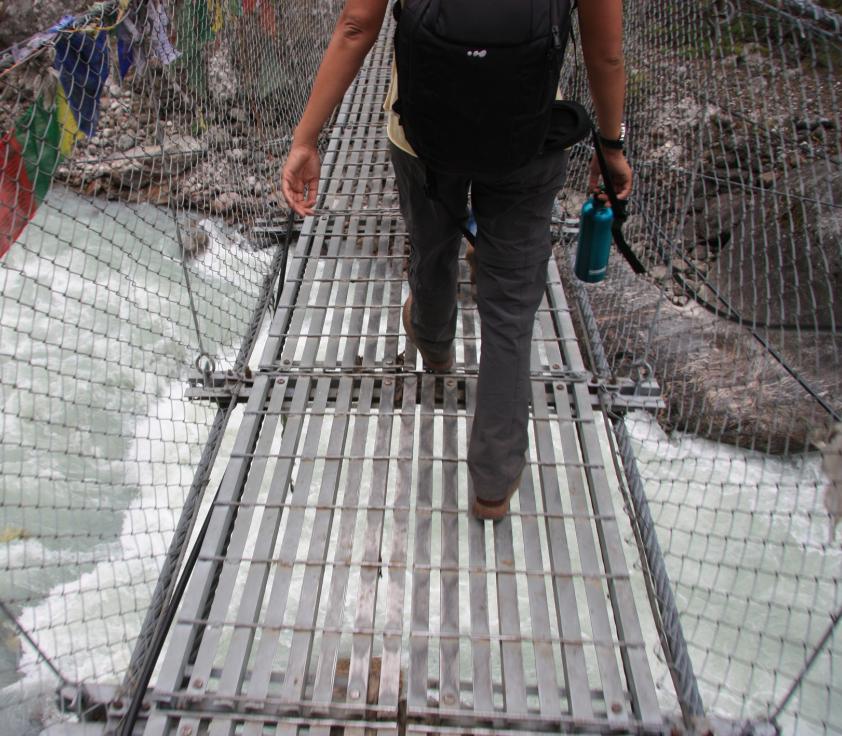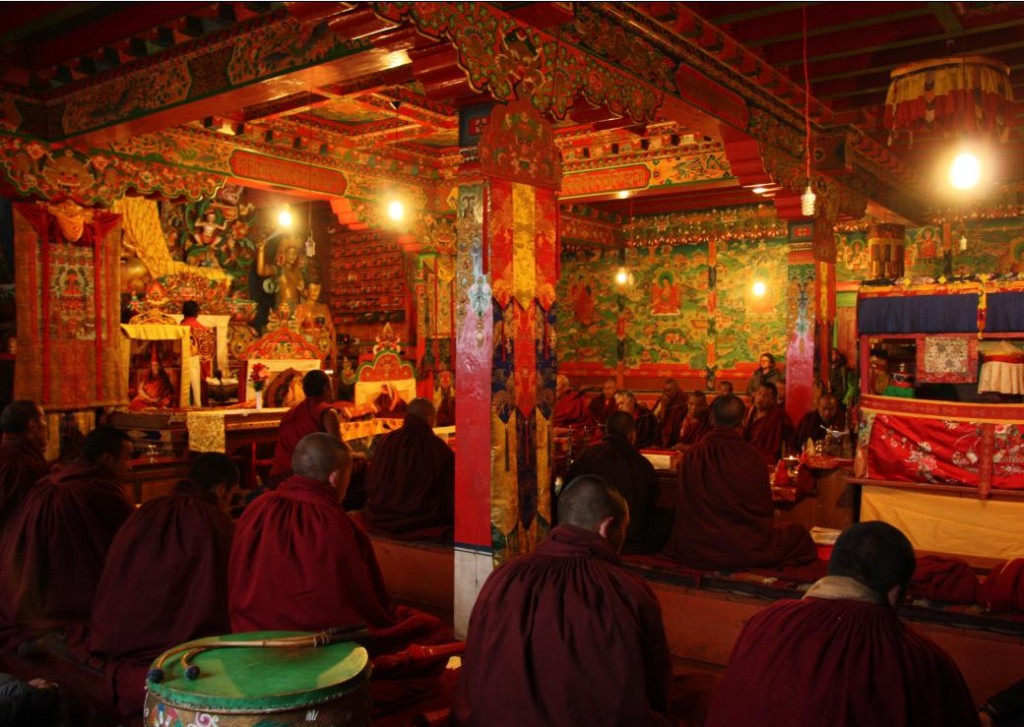Continued from part 1…
We start our second day crossing the Dudh Kosi (Milk River) on a steel suspension bridge about 50 metres (165ft) above the river – it’s a thrilling feeling with mountains on each side and the roaring river below. As we cross, the wind pushes us to one side and you feel slightly unbalanced and we both have butterflies in our stomachs.
The last 3 hours of the day’s trek is a steep ascent – more than 1000 meters – just up, up, up…until we finally reach Namche Bazaar at 3,440 metres (11,286 ft). This was definitely physically the hardest day of the whole trek but the next day is a rest day to give our bodies more time to acclimatize to the altitude. Well, “rest day” – the term is a bit misleading and sounds better than what it is. The point of a rest day is to climb above the altitude you are sleeping at, spend a couple of hours and then descend. This will help the body acclimatize faster. So we climb 350 metres (1150ft) uphill, have a break while watching recreational planes land and take off. The attraction is the highest located hotel with a view of Mt. Everest at 3880m (12,730 ft). So if you are rich enough you can fly directly to this hotel spare yourself the walking, see Everest and fly back. In the afternoon we watch the movie Into Thin Air based on Jon Krakauer’s account of the fatal summit attempts in 1996.
For days we walk along narrow trails that wind around cliffs, go down to the bottom so that we can cross the river that runs through, then it’s back up the mountain, around the mountain, ascending, descending, ascending…We walk through valleys surrounded by beautiful blankets of autumn colors. The smell of pine forests remind me of walks with my mom back in Denmark where I grew up. But Denmark is one of the flattest countries on earth and Nepal one of the highest. The contrast could almost not be bigger.
It gets colder in the mornings and the landscape becomes more barren and unforgiving. At Tengboche (4,360 m/14,300 ft) we spend our second rest day. There is not much to do; the village seems to only exist for the trekkers passing through except the monastery (which must be the highest located monastery in the world!) which is now said to be home to 60 monks, reflecting its financial prosperity. However, it is also said that fewer and fewer young boys join as monks as they prefer to work in mountaineering or trekking-related activities.
It was my first experience inside a Buddhist monastery – the humming sound of about 40 monks chanting prayers was slightly hypnotic and calming and because I didn’t really understand what was going on it became all the more exotic and mysterious.
Nowhere in the world is a trek more spectacular than in the Everest region. It’s where four of the world’s six tallest peaks Mount Everest, Lhotse, Makalu, and Cho Oyu rise above everything else, crowning the towering ridges that straddle the Himalaya.
Mountains make you feel small and insignificant – in a good way – it makes you see yourself in a different perspective. While walking you have time to reflect on so many things that you might not normally do in your everyday life. It makes trekking therapeutic experience both mentally and physically.
We are starting to feel the altitude; slight headaches and short-of-breath-ness. Our guide assures us that eating loads of garlic will cure our symptoms, so we eat cloves of raw uncooked garlic. I’m sure our breaths must have smelled really well…
Late morning on day 9 we reach Gorak Shep – a 3 hour trek from Lobuche. We are now at (5170 m/16,961ft) After an early lunch we take the trail to Everest Base Camp through the once vast Gorak Shep Lake. It’s strange to see sand and sea shells at this altitude. After a couple of hours we reach the Khumbu Icefall which is regarded as one of the most dangerous stages of the South Col route to Everest’s summit. Climbing through the icefall can be an extremely dangerous adventure as the icefall is continually moving, sometimes as much as two to three feet in an hour, and I’m happy that we are not doing that. We have reached the goal of our trek. We are standing at the foot of the tallest mountain above sea level! It’s incredible!
When we arrive back at Gorak Shep, my husband is not feeling well. He is nauseous and has a headache – clear symptoms of AMS (Acute Mountain Sickness) and that your body has not acclimatized well. We go to our room to take a rest before dinner – he is still not feeling well after an hour and I’m starting to get a little cold. Like most lodges along the way, this one also consists of 4 wooden walls, no insulation and a little window. I go downstairs to order a hot drink and to inform our guide that my husband is not feeling so good. Our guide jumps to his feet and runs up to our room to check on my husband. Within 3 minutes he is back downstairs to inform me that we are leaving NOW! We have to pack and leave NOW – immediately. I’m too focused on leaving instantly that I don’t have time to be nervous about my husband, and I trust that we are in safe hands.
It’s 5.30pm and the sun has just set over the Himalaya and we are about to walk on a small stony path – IN THE DARK! Now that’s scary! Luckily, we have a full moon so the landscape is slightly lit up and this merciless place corresponds to what I imagine it must be like to be walking on the moon. There are no sounds in the night – only our footsteps on rocks can be heard – it’s absolutely silent, like we’re wrapped in an invisible blanket. It’s so beautiful and unreal – this moon landscape at the top of the world; it’s rough and poetic at the same time.
We finally get down to an altitude of about 4280 m (14,070 ft) and we will stop here for the night. Thank goodness the decent seems to have helped my husband’s condition; he says he feels better. Or maybe he’s just too exhausted to feel sick. I’m exhausted – it’s been a long day with a 7am start and it’s now 9pm. Last time we ate was 10 hours ago. My husband goes straight to bed and the guide and I eat a small bowl of noodle soup.
We backtrack down to Lukla over the next couple of days and it feels good to be finishingour trek. It was an amazing experience – an experience you could never have predicted. It’s definitely a honeymoon to remember – but I’m sure most honeymoon couples will tell you that. It almost feels like this was a symbolic trip of what is in store for us in our future life together – sometimes life is uphill and you’re out of breath, but after that it’s downhill and life is effortless and sometimes you don’t feel well, but by supporting each other we will make it. We started this journey together and we are going to finish it together.
~ By guest blogger, Ann Wilson. Ann is founder and CEO of Friends of VIN. She lives in Netherlands with her husband and travels to Nepal every chance she gets. To support Friends of VIN, visit www.friendsofvin.nl


